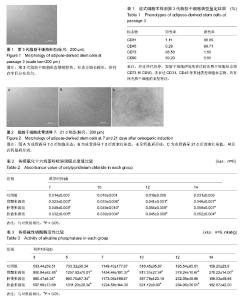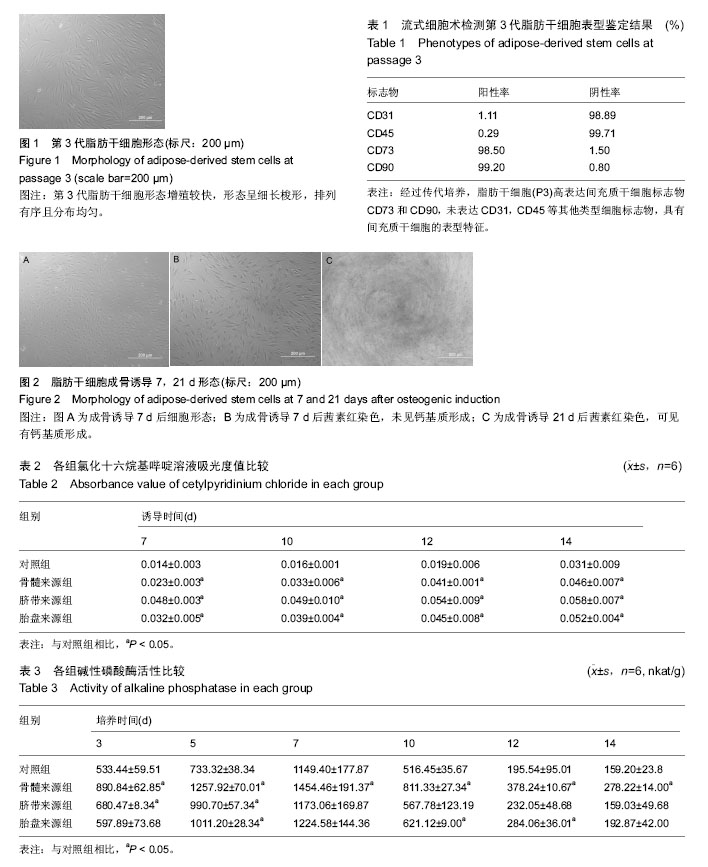Chinese Journal of Tissue Engineering Research ›› 2016, Vol. 20 ›› Issue (28): 4155-4161.doi: 10.3969/j.issn.2095-4344.2016.28.008
Previous Articles Next Articles
Osteogenic efficiency of induced adipose-derived stem cells under Transwell co-cultured condition
Sun Shi-chen, Dong Teng-zhe, Huang Xin, Zhang Yun-long, Chen Gang
- Department of Oral and Maxillofacial Surgery, Stomatological Hospital, Tianjin Medical University, Tianjin 300070, China
-
Revised:2016-05-16Online:2016-07-01Published:2016-07-01 -
Contact:Chen Gang, M.D., Professor, Department of Oral and Maxillofacial Surgery, Stomatological Hospital, Tianjin Medical University, Tianjin 300070, China -
About author:Sun Shi-chen, Studying for master’s degree, Department of Oral and Maxillofacial Surgery, Stomatological Hospital, Tianjin Medical University, Tianjin 300070, China -
Supported by:the Scientific Research Foundation for the Returned Overseas Chinese Scholars, State Education Ministry of China, No. (2012)940
CLC Number:
Cite this article
Sun Shi-chen, Dong Teng-zhe, Huang Xin, Zhang Yun-long, Chen Gang. Osteogenic efficiency of induced adipose-derived stem cells under Transwell co-cultured condition [J]. Chinese Journal of Tissue Engineering Research, 2016, 20(28): 4155-4161.
share this article

2.1 脂肪干细胞形态 脂肪干细胞原代培养24 h后可见少量细胞贴壁,细胞形状不规则,呈卵圆形或多边形。培养至第7天细胞形态呈长梭形、多角型及不规则型,融合程度达80%。细胞传代培养至第3代,增殖较快,形态呈细长梭形,排列有序且分布均匀(图1)。 2.2 脂肪干细胞表型鉴定结果 流式细胞检测显示提取的脂肪干细胞在传代培养第3代时高表达间充质干细胞标志物CD73和CD90,未表达CD31和CD45等其他类型细胞标志物(表1),与以往文献报道一致[16],证实所提取细胞为脂肪干细胞。 2.3 各组钙化基质形成情况 脂肪干细胞成骨诱导7 d后,细胞形态改变,胞体逐渐变大并逐渐变成多边形(图2A),茜素红染色显示无钙基质沉积(图2B)。诱导21 d后,茜素红染色可见有钙基质形成(图2C)。 钙基质定量分析结果如表2所示,实验组CPC溶液吸光度值在各时间点均高于对照组(P < 0.05),脐带来源组在各时间点吸光度值最大(P < 0.05),胎盘来源组吸光度值在诱导7 d时高于骨髓来源组(P < 0.05),诱导10-14 d虽高于骨髓来源组但差异无显著性意义(P > 0.05)。 2.4 各组碱性磷酸酶活性变化 各组细胞在整个培养阶段碱性磷酸酶活性呈现出相似的趋势,矿化培养液中培养第7天时碱性磷酸酶活性达到峰值,培养第7-14天碱性磷酸酶活性逐渐下降。在整个实验观察期间,骨髓来源组碱性磷酸酶活性在各时间间期始终为最高(P < 0.05)。脐带来源组碱性磷酸酶活性在培养第3-5天时显著高于对照组(P < 0.05)。胎盘来源组碱性磷酸酶活性在培养第3-5天和第10-12天时显著高于对照组(P < 0.05),见表3。"

| [1] Wu X, Ren J, Li J. Fibrin glue as the cell-delivery vehicle for mesenchymal stromal cells in regenerative medicine. Cytotherapy. 2012;14(5):555-562. [2] Mizuno H, Tobita M, Uysal AC. Concise review: adipose-derived stem cells as a novel tool for future regenerative medicine. Stem Cells. 2012;30(5): 804-810. [3] Wen Y, Jiang B, Cui J, et al. Superior osteogenic capacity of different mesenchymal stem cells for bone tissue engineering. Oral Surg Oral Med Oral Pathol Oral Radiol. 2013;116(5):e324-332. [4] Kou L, Lu XW, Wu MK, et al. The phenotype and tissue-specific nature of multipotent cells derived from human mature adipocytes. Biochem Biophys Res Commun. 2014;444(4):543-548. [5] Tsuji W, Rubin J, PMarra KG. Adipose-derived stem cells: Implications in tissue regeneration. World J Stem Cells. 2014;6(3):312-321. [6] Senarath-Yapa K, McArdle A, Renda A, et al. Adipose-derived stem cells: a review of signaling networks governing cell fate and regenerative potential in the context of craniofacial and long bone skeletal repair. International Journal of Molecular Sciences. 2014;15(6):9314-9330. [7] Glueck M, Gardner O, Czekanska E, et al. Induction of Osteogenic Differentiation in Human Mesenchymal Stem Cells by Crosstalk with Osteoblasts. Biores Open Access. 2015;4(1):121-130. [8] Schipani E, Wu C, Rankin EB, et al. Regulation of Bone Marrow Angiogenesis by Osteoblasts during Bone Development and Homeostasis. Front Endocrinol (Lausanne). 2013;4(3):85-91. [9] Fujita K, Xing Q, Khosla S, et al. Mutual enhancement of differentiation of osteoblasts and osteocytes occurs through direct cell-cell contact. J Cell Biochem. 2014; 115(11):2039-2044. [10] Santos TS, Abuna RP, Castro Raucci LM, et al. Mesenchymal Stem Cells Repress Osteoblast Differentiation Under Osteogenic-Inducing Conditions. J Cell Biochem. 2015;116(12):2896-2902. [11] Olivares-Navarrete R, Hyzy SL, Hutton DL, et al. Direct and indirect effects of microstructured titanium substrates on the induction of mesenchymal stem cell differentiation towards the osteoblast lineage. Biomaterials. 2010;31(10): 2728-2735. [12] Rinker TE, Hammoudi TM, Kemp ML, et al. Interactions between mesenchymal stem cells, adipocytes, and osteoblasts in a 3D tri-culture model of hyperglycemic conditions in the bone marrow microenvironment. Integr Biol (Camb). 2014;6(3): 324-337. [13] Stenderup K, Justesen J, Eriksen EF, et al. Number and proliferative capacity of osteogenic stem cells are maintained during aging and in patients with osteoporosis. J Bone Miner Res. 2001;16(6):1120-1129. [14] Dawson JI, Smith JO, Aarvold A, et al. Enhancing the osteogenic efficacy of human bone marrow aspirate: concentrating osteoprogenitors using wave-assisted filtration. Cytotherapy. 2013;15(2):242-252. [15] 张圣敏,陈刚,王晨星,等.人颊脂垫脂肪干细胞与皮下脂肪干细胞生物学特性的比较[J].中国组织工程研究,2012, 16(32):5941-5945. [16] Bogdanova A, Berzins U, Nikulshin S, et al. Characterization of human adipose-derived stem cells cultured in autologous serum after subsequent passaging and long term cryopreservation. J Stem Cells. 2014;9(3):135-148. [17] Rosenberg N, Rosenberg O, Soudry M. Osteoblasts in bone physiology-mini review. Rambam Maimonides Med J. 2012;3(2):e0013-e0020. [18] Ratisoontorn C, Seto ML, Broughton KM, et al. In vitro differentiation profile of osteoblasts derived from patients with Saethre-Chotzen syndrome. Bone. 2005; 36(4):627-634. [19] Panepucci RA, Siufi JL, Silva WA Jr., et al. Comparison of gene expression of umbilical cord vein and bone marrow-derived mesenchymal stem cells. Stem cells (Dayton, Ohio). 2004;22(7):1263-1278. [20] Chen J, Singh K, Mukherjee BB, et al. Developmental expression of osteopontin (OPN) mRNA in rat tissues: evidence for a role for OPN in bone formation and resorption. Matrix (Stuttgart, Germany). 1993;13(2): 113-123. [21] de Oliveira PT, Zalzal SF, Irie K, et al. Early expression of bone matrix proteins in osteogenic cell cultures. Histochem Cytochem. 2003;51(5):633-641. [22] Ulrich C, Rolauffs B, Abele H, et al. Low osteogenic differentiation potential of placenta-derived mesenchymal stromal cells correlates with low expression of the transcription factors Runx2 and Twist2. Stem Cells dev. 2013;22(21):2859-2872. [23] Fan Z X, Lu Y, Deng L, et al. Placenta- versus bone-marrow-derived mesenchymal cells for the repair of segmental bone defects in a rabbit model. FEBS J. 2012;279(13):2455-2465. [24] Madrigal M, Rao KS, Riordan NH. A review of therapeutic effects of mesenchymal stem cell secretions and induction of secretory modification by different culture methods. J Transl Med. 2014; 12(2): 260-274. [25] Ando Y, Matsubara K, Ishikawa J, et al. Stem cell-conditioned medium accelerates distraction osteogenesis through multiple regenerative mechanisms. Bone. 2014;61(8):82-90. [26] Wang KX, Xu LL, Rui YF, et al. The effects of secretion factors from umbilical cord derived mesenchymal stem cells on osteogenic differentiation of mesenchymal stem cells. PLoS One. 2015;10(3):e0120593- e0120609. [27] Kmiecik G, Spoldi V, Silini A, et al. Current view on osteogenic differentiation potential of mesenchymal stromal cells derived from placental tissues. Stem Cell Rev. 2015;11(4):570-585. [28] Osathanon T, Nowwarote N, Manokawinchoke J, et al. bFGF and JAGGED1 regulate alkaline phosphatase expression and mineralization in dental tissue-derived mesenchymal stem cells. J Cell Biochem. 2013; 114 (11): 2551-2561. [29] 杨冰,周慧,樊飞跃,等.Notch信号转导通路在骨形成和重建中的调节作用[J].天津医药,2011,39(2):190-192. [30] 顾新丰,蒋垚.RUNX2研究进展[J].医学分子生物学杂志, 2006,3(1):52-54. [31] Ardeshirylajimi A, Soleimani M, Hosseinkhani S, et al. A comparative study of osteogenic differentiation human induced pluripotent stem cells and adipose tissue derived mesenchymal stem cells. Cell J. 2014; 16(3):235-244. |
| [1] | Pu Rui, Chen Ziyang, Yuan Lingyan. Characteristics and effects of exosomes from different cell sources in cardioprotection [J]. Chinese Journal of Tissue Engineering Research, 2021, 25(在线): 1-. |
| [2] | Lin Qingfan, Xie Yixin, Chen Wanqing, Ye Zhenzhong, Chen Youfang. Human placenta-derived mesenchymal stem cell conditioned medium can upregulate BeWo cell viability and zonula occludens expression under hypoxia [J]. Chinese Journal of Tissue Engineering Research, 2021, 25(在线): 4970-4975. |
| [3] | Zhang Tongtong, Wang Zhonghua, Wen Jie, Song Yuxin, Liu Lin. Application of three-dimensional printing model in surgical resection and reconstruction of cervical tumor [J]. Chinese Journal of Tissue Engineering Research, 2021, 25(9): 1335-1339. |
| [4] | Zhang Xiumei, Zhai Yunkai, Zhao Jie, Zhao Meng. Research hotspots of organoid models in recent 10 years: a search in domestic and foreign databases [J]. Chinese Journal of Tissue Engineering Research, 2021, 25(8): 1249-1255. |
| [5] | Hou Jingying, Yu Menglei, Guo Tianzhu, Long Huibao, Wu Hao. Hypoxia preconditioning promotes bone marrow mesenchymal stem cells survival and vascularization through the activation of HIF-1α/MALAT1/VEGFA pathway [J]. Chinese Journal of Tissue Engineering Research, 2021, 25(7): 985-990. |
| [6] | Shi Yangyang, Qin Yingfei, Wu Fuling, He Xiao, Zhang Xuejing. Pretreatment of placental mesenchymal stem cells to prevent bronchiolitis in mice [J]. Chinese Journal of Tissue Engineering Research, 2021, 25(7): 991-995. |
| [7] | Liang Xueqi, Guo Lijiao, Chen Hejie, Wu Jie, Sun Yaqi, Xing Zhikun, Zou Hailiang, Chen Xueling, Wu Xiangwei. Alveolar echinococcosis protoscolices inhibits the differentiation of bone marrow mesenchymal stem cells into fibroblasts [J]. Chinese Journal of Tissue Engineering Research, 2021, 25(7): 996-1001. |
| [8] | Fan Quanbao, Luo Huina, Wang Bingyun, Chen Shengfeng, Cui Lianxu, Jiang Wenkang, Zhao Mingming, Wang Jingjing, Luo Dongzhang, Chen Zhisheng, Bai Yinshan, Liu Canying, Zhang Hui. Biological characteristics of canine adipose-derived mesenchymal stem cells cultured in hypoxia [J]. Chinese Journal of Tissue Engineering Research, 2021, 25(7): 1002-1007. |
| [9] | Geng Yao, Yin Zhiliang, Li Xingping, Xiao Dongqin, Hou Weiguang. Role of hsa-miRNA-223-3p in regulating osteogenic differentiation of human bone marrow mesenchymal stem cells [J]. Chinese Journal of Tissue Engineering Research, 2021, 25(7): 1008-1013. |
| [10] | Lun Zhigang, Jin Jing, Wang Tianyan, Li Aimin. Effect of peroxiredoxin 6 on proliferation and differentiation of bone marrow mesenchymal stem cells into neural lineage in vitro [J]. Chinese Journal of Tissue Engineering Research, 2021, 25(7): 1014-1018. |
| [11] | Zhu Xuefen, Huang Cheng, Ding Jian, Dai Yongping, Liu Yuanbing, Le Lixiang, Wang Liangliang, Yang Jiandong. Mechanism of bone marrow mesenchymal stem cells differentiation into functional neurons induced by glial cell line derived neurotrophic factor [J]. Chinese Journal of Tissue Engineering Research, 2021, 25(7): 1019-1025. |
| [12] | Duan Liyun, Cao Xiaocang. Human placenta mesenchymal stem cells-derived extracellular vesicles regulate collagen deposition in intestinal mucosa of mice with colitis [J]. Chinese Journal of Tissue Engineering Research, 2021, 25(7): 1026-1031. |
| [13] | Pei Lili, Sun Guicai, Wang Di. Salvianolic acid B inhibits oxidative damage of bone marrow mesenchymal stem cells and promotes differentiation into cardiomyocytes [J]. Chinese Journal of Tissue Engineering Research, 2021, 25(7): 1032-1036. |
| [14] | Guan Qian, Luan Zuo, Ye Dou, Yang Yinxiang, Wang Zhaoyan, Wang Qian, Yao Ruiqin. Morphological changes in human oligodendrocyte progenitor cells during passage [J]. Chinese Journal of Tissue Engineering Research, 2021, 25(7): 1045-1049. |
| [15] | Wang Zhengdong, Huang Na, Chen Jingxian, Zheng Zuobing, Hu Xinyu, Li Mei, Su Xiao, Su Xuesen, Yan Nan. Inhibitory effects of sodium butyrate on microglial activation and expression of inflammatory factors induced by fluorosis [J]. Chinese Journal of Tissue Engineering Research, 2021, 25(7): 1075-1080. |
| Viewed | ||||||
|
Full text |
|
|||||
|
Abstract |
|
|||||